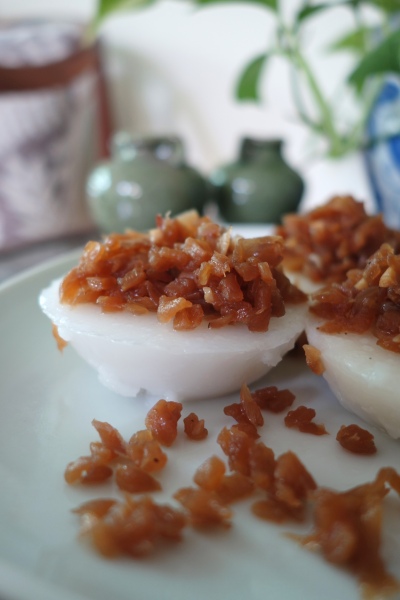
When I was a little kid, I used to follow my mum to the wet market on Sunday mornings. Being a chubby, greedy child, there was one thing that motivated me to accompany her to the hot, stuffy market with her–the chwee kueh stall.
Growing up, we ate this traditional Chinese snack only on Sundays when everyone did not have to hurry through the morning, and we had time to go to the market to buy some. They were handmade and at Siglap Market, the ladies who made the chwee kueh did them fabulously.
Chwee kueh are steamed rice flour cakes, gelatinous and wobbly, mild in flavour on its own. But their toppings of preserved radish, or chai poh, held together in oil-laden unctuousness is the stuff of gustatory dreams. Umami-rich, savoury with a lingering sweetness, with depth of flavour from slowly sautéed garlic and soy sauce, it is complex and comforting and downright delicious. Add to that the crunchy texture of chai poh and it is a mouthful made in heaven. Decades on, chwee kueh is still ranks among the top five of my favourite breakfast foods. Thankfully I can always buy them at the hawker stalls. My only beef is that they are pretty stingy with the toppings, and too little of it will spoil the enjoyment completely.

So I have learnt to make my own chwee kueh, and heap it with as much of the chai poh topping as I want. It took me a few attempts to get it right, and while this may not be absolutely perfect yet, the recipe below gives a good, enjoyable rendition which I am happy to share.
The technique in this recipe is as important as the ingredients. It is crucial to:
• Steam the little moulds beforehand so the batter comes into contact with its hot surface and has no chance to cool (see picture above). It has to ‘hit the ground running’ at the point of steaming;
• Use very freshly boiled water to stir into the batter, as the hot water will thicken the batter somewhat and that is important.
• Use the stipulated flours. I tried using tapioca flour instead of corn flour once with disastrous results.
If you don’t have little metal moulds, you could try using little dishes instead. Note the depth of the batter—too thick in the middle and it may not cook properly. Have fun and enjoy!

Makes about 20 150 g rice flour Topping Method *Chai Poh is preserved radish. It comes in both sweet and salty versions. Using both in this dish gives a more balanced, complex flavour of greater depth compared to using just sweet or salty chai poh.Chwee Kueh
1 Tbsp wheat starch (tung fen/ dim sum flour)
11/2 tsp corn flour
3 Tbsp oil
160 ml tap water
500 ml freshly boiled water
A pinch of salt
6 Tbsp cooking oil
6 cloves garlic, chopped
10 cloves shallots chopped
100 grams salty chai poh
150g sweet chai poh
1 Tbsp dark soy sauce or to taste
2 Tbsp light soy sauce or to taste
1 Tbsp sugar
• Lightly grease moulds and place in a steamer over simmering water. (You want to heat the moulds first as they should be hot when you pour in the batter.)
• Meanwhile, combine batter ingredients except for the boiling water in a large bowl. Mix into a smooth paste. Then stir in the freshly boiled water.
• Quickly pour the batter into the moulds in the steamer. Cover and steam for 45-50 mins.
• While it is steaming, make the topping. Heat the cooking oil in a wok. When it is hot, sauté garlic and shallots over medium flame until aromatic. About 5 mins.
• Add chai poh, dark and light soy sauce, sugar and sauté for about 10 minutes until fragrant. Set aside.
• When the chwee kueh is steamed, remove from steamer and let it cool completely at room temperature. It should set and firm up a little more.
• Unmould with a thin knife and serve with topping.
My very first memories of food includes this. Still a favourite.
LikeLiked by 1 person
Where did you have them?
LikeLike
Singapore. In fact I know exactly which (now sadly non-existent) hawker stand it came from.
LikeLiked by 1 person
Oh! What a small world! You and I share a memory then! 🙂 You were from Singapore?
LikeLiked by 1 person
You’re from S’pore too? Nice! Which are your favourite hawker centre dishes?
LikeLiked by 1 person
Yes, also from Singapore! 🙂 Not surprisingly, I have too many favourite hawker dishes–laksa, mee siam, mee rebus, bak chor mee, prata, hum cheen pang, chwee kueh, chai tow kuay (black version), briyani, chicken rice….And yours?
BTW where can I buy your book?
LikeLiked by 1 person
Roti prata (with tonnes of that curry), wonton mee (dry), popiah, laksa, chicken rice, otak, bahkuteh, nasi lemak (with everything and a fried chicken wing)…
You can buy the book at: https://www.berkshirepublishing.com/title/yuan-meis-manual-gastronomy/
If you are interested in trying to cook from the book I can send you a few recipes I’ve put together!
LikeLiked by 1 person
Thank you so much. I would love that! And thanks for the link. Must have been a long project for you, but thanks for doing it!
LikeLiked by 1 person
It’s been a long road indeed 🙂
LikeLiked by 1 person
But it must be immensely gratifying, and I look forward to reading and learning from it. 🙂
LikeLiked by 1 person